At the end of World War I– between the fall of 1918 and the early 1920s– an influenza pandemic was stealing millions and millions of lives all over the world. It was a contagious, ruthless flu that preferred to take the breath away from adults in the prime of life–but in the end everybody was at risk.
The Coastside was isolated and that’s why folks from the surrounding areas thought they could escaqpe falling ill here. Entire families rented cute Ocean Shore Railroad era cottages that San Franciscans had built as second homes or to commute to the City from.
The pandemic hit the Coastside in mid-September 1918. The killer virus struck locals who, through their work and social status, had contact with many more people. Harry Nelson, the postman fell ill so did Father J. Sorasio.
Here were the reported symptoms,typical of the average flu: First fever, headaches and backaches. Bed rest and plenty of liquids was recommended but this time the prescription failed.
If you read Alfred Crosby’s book, “The Forgotten Pandemic: The Influenza of 1918”, he writes that death came quickly for many victims, with autopsies showing blue, swollen lungs filled with a thin, bloody fluid.
People were terrified. They suspected coughs and sneezes were passing the virus. San Francisco enacted legislation requiring everybody to wear a mask when in public.
I’m sure there was great sadness down at Pigeon Point, south of Pescadero, when the two young sisters Emma and Clara Steele fell ill and never recovered to live out the rest of their lives. As the flu spread its blanket of doom and gloom, Half Moon Bay closed schools and set up “hospitals” inside private homes. But nurses and doctors were scarce as they had too many patients to care for and caught the flu themselves.
Clara (second from left}  and Emma Steele, reclining, young Coastsiders who fell victim to the flu in 1918. Photo courtesy Mrs. Stanley Steele
and Emma Steele, reclining, young Coastsiders who fell victim to the flu in 1918. Photo courtesy Mrs. Stanley Steele
